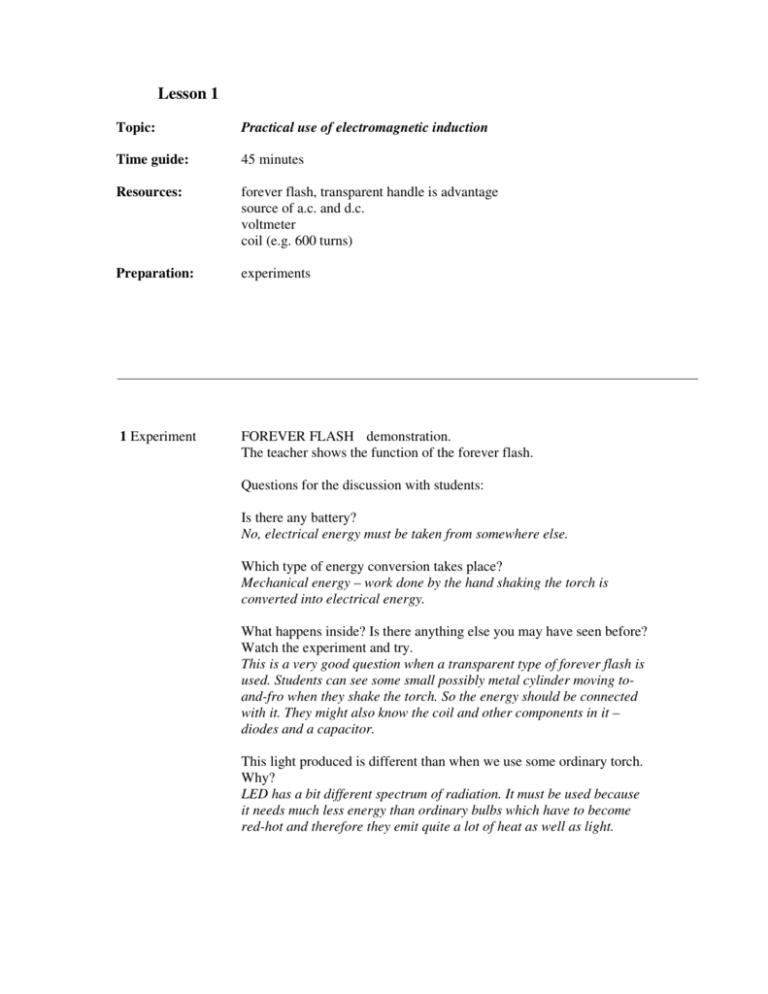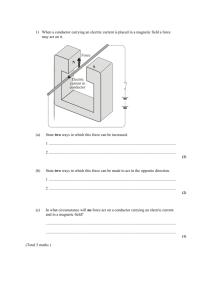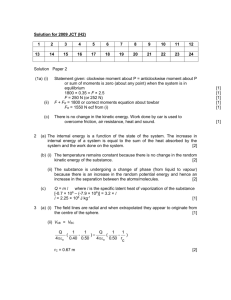Electromagnetic induction
advertisement

Lesson 1
Topic:
Practical use of electromagnetic induction
Time guide:
45 minutes
Resources:
forever flash, transparent handle is advantage
source of a.c. and d.c.
voltmeter
coil (e.g. 600 turns)
Preparation:
experiments
1 Experiment
FOREVER FLASH demonstration.
The teacher shows the function of the forever flash.
Questions for the discussion with students:
Is there any battery?
No, electrical energy must be taken from somewhere else.
Which type of energy conversion takes place?
Mechanical energy – work done by the hand shaking the torch is
converted into electrical energy.
What happens inside? Is there anything else you may have seen before?
Watch the experiment and try.
This is a very good question when a transparent type of forever flash is
used. Students can see some small possibly metal cylinder moving toand-fro when they shake the torch. So the energy should be connected
with it. They might also know the coil and other components in it –
diodes and a capacitor.
This light produced is different than when we use some ordinary torch.
Why?
LED has a bit different spectrum of radiation. It must be used because
it needs much less energy than ordinary bulbs which have to become
red-hot and therefore they emit quite a lot of heat as well as light.
Summary
We have seen that electrical energy needed for the function of the torch
need not come from an obvious source – a battery (simple cell). We
have produced electrical energy just by shaking the torch. A piece of
metal (permanent magnet) has moved to-and-fro inside a coil.
2
Do you know anything about the function of the power station where
electricity is produced? Mention some types of power stations. What do
they have in common?
Discussion based on the description of different types of power stations.
In the water power station the water rotates the propellers of the
turbine. In other types including the nuclear one any kind of fuel is
burned to get heat. This is used obviously to make steam for the steam
turbine, so again propellers will be rotated.
The teacher leads students to realize that, no matter what is the type of
power station, mechanical energy as rotation is obtained. This must be
somehow used to produce electrical energy.
Summary
When we want to produce electrical energy (current, voltage), either
chemical changes (in cells) or movement is essential.
In the following parts we have to describe the „movement“ in more
details.
3 Experiment
voltmeter or ammeter connection
coil (e.g. 600 turns)
strong permanent magnet
The teacher reminds the students the function of a moving-coil
voltmeter and ammeter, a transparent type of the device is
recommended:
moving-coil meter
•
•
•
no source - battery inside
current passing the coil of the meter creates the magnetic field,
which reacts with the outer magnetic field and the pointer which
shows the values is deflected
optional discussion – further details in construction e.g. hair
springs
coil connected to the meter
•
consists of a copper wire only, no source of electrical energy
again
The teacher moves the magnet towards the coil and away from it. The
voltmeter shows a deflection in one direction when the magnet is moved
closer and in opposite direction when it moves away. When the magnet
stays at rest, though close to the coil or even inside, there is no
deflection.
Is the pure presence of the magnetic field the only important thing for
„making“ the voltage?
No, because when the magnet is placed near the coil or close to it, the
coil must be in its magnetic field but nothing is induced.
What is so different for the coil when the magnet moves?
The magnetic field changes.
Summary
We have seen, that relative movement of a magnet and a coil produces
a voltage. When there is no movement so no change of the magnetic
field,no voltage is induced.
4 Revision
We have seen that electricity can be produced without a simple cell
when we produce relative motion between a coil and a permanent
magnet. Example of that is e.g. the „forever flash“, but it cannot contain
an ordinary bulb, because it needs too much energy to light. Light
emitting diodes are much better. The constuction of the device will be
discussed later in more detail. The demonstration with the coil helps to
understand us the principle. During the next lessom we are going to
take a close look at the laws of electromagnetic induction – which
things are important for the size of the voltage induced and what is the
direction of the voltage induced.
Lesson 2
Topic:
Faraday’s and Lenz’s law
Time guide:
45 minutes
Resources:
students should use the worksheets
equipment for experiment 3 from lesson 2
Preparation:
experiment 3 from the previous lesson but with 2 different coils and 2
magnets of different strength
1 Magnetic flux
Magnetic flux is a new physical quantity needed to describe the
CHANGES of the magnetic field related to certain area (e.g. inside a
loop or a coil) – the field can in fact stay the same, but it changes for the
area moving (e.g. rotating)
α
A
A
B
→
Φ = BA
when A ⊥ B :
for any α :
Φ = BA cos α
for α = ωt :
Φ = BA cos ωt
(regulary rotating area)
[Φ ] = T m 2 = Wb (weber )
2 Faraday’s law
The teacher shows experiment 3 again and the coil is replaced by
another one with a different number of loops, the magnet is replaced by
stronger one and the relative movement is faster or slower. From that
students can derive that bigger voltage is induced when we use:
•
•
•
a coil with more loops
a stronger magnet
faster relative movement of the coil and the magnet
The rate of change of fluxlinkage or flux is directly proportional to
the electromotive force induced
fluxlinkage = NΦ when the coil in the magnetic field has N
loops(turns), the flux changes in each of them so that the voltage
induced must be N-times bigger
Ui ∝
d (NΦ )
dt
Ui ∝
N∆Φ
∆t
for regular changes of flux during t
E.g. when the flux in a single-turn coil changes by 1Wb during 1s, the
voltage induced is 1V.
3 Lenz’s law
The direction of the electromotive force is such that it tends to oppose
the flux change causing it and it does oppose if induced current flows.
d (NΦ )
dt
N∆Φ
Ui = −
for regular changes of flux during t
∆t
Ui = −
To prove this statement experiment 3 can be used again. The students
should be asked to concentrate on the direction of the voltage induced.
4 Revision
We have introduced a new physical quantity magnetic flux, which is
important to describe the electromagnetic induction. The magnetic flux
represents the changes of the magnetic field for a certain area,
obviously the inner area of a coil. Then we have realized that when the
magnetic flux changes for certain loop or conductor voltage is induced.
The size of this voltage is determined by the Faraday’s law, its
direction by the Lenz’s law.
Lesson 3
Topic:
Applications
Time guide:
45 minutes
Resources:
forever flash
model of a motor/generator, video
strong magnet
sheets of iron, lead and copper
core of a transformer
Preparation:
experiments
1 Voltage/current
induced
This is used as a source of electrical energy. We supply mechanical
energy either to shake the forever flash (linear to-and-fro motion) or to
rotate a coil in the outer magnetic field (rotary motion; sometimes a
magnet or electromagnet is rotated in the coil).
When a magnetic field changes relative to the coil voltage is induced
and when it is possible induced current flows.
Schools have lots of different equipment to show the production of
electrical energy by induction. The process is also on videos or on the
internet – make the experiment and show the video, discuss!
2 Eddy currents
Eddy currents are present when a large sample of conducting material is
placed into a changing magnetic field → electric field is induced within
the sample and induced current can flow when the block is uniform
Experiment
What do you feel when the magnet moves above the metal placed on
your hand? Explain.
moving
magnet
sheet of conducting material : iron, copper, lead
Students are given samples of different conducting materials and they
are asked to move a strong magnet (e.g. from old hard disc) above them
as close as possible – as a „simple pendulum“. They should describe
what they feel and try to explain it.
Iron is just attracted and we cannot move the magnet above – this will
remind the students of the properties of ferromagnetic materials.
Copper seems to slow down the movement of the magnet and it also
tends to follow it a bit.
Lead has much weaker effect – if detected at all.
Explanation
Eddy currents induced against the changes of the outer magnetic field
produce a magnetic field which tends to slow down the movement of
the magnet – „work against the change“. Copper is much better
conductor than lead (more free electrons) and that is why the effect is
much stronger.
Use
paying for electricity – in some of the devices installed in any house to
measure the consumption of electrical energy an aluminium disc rotates
between the magnets and it keeps rotating when we use the electricity.
When all the appliances are off, the eddy currents induced in the disc
will stop it ( so that inertia of the disc does not affect the measurement
and therefore the cost ).
refining metals and manufacture of monocrystals
moving high-frequency coil
pure single crystal
molten zone
impure polycrystalline
semiconductor or metal
Problems in
cores of transformers
cross-section of ordinary core
outer current
cross-section of laminated core
outer current
eddy current induced
no eddy currents
because of insulated
sheets of iron =
laminations
If we allow eddy currents to flow, their magnetic field would reduce
the effect of the outer field caused by the current in the coil (bad for
induction on the secondary coil) and they can as well produce heat!!!
Lesson 4
Topic:
Problem solving
Time guide:
45 minutes
Resources:
students worksheets, calculator
Preparation:
calculation
1 Problems
1. State the direction of the current
induced in a loop L on Fig.1 when
the outer circuit is switched on.
L
Fig.1
The conventional current in the outer loop flows clockwise, so the
induced current would flow against the change – ANTICLOCKWISE.
2. A bar magnet is falling inside a long vertical solenoid. Does its speed
rise at the same rate as if it is falling just in air?
NO, because as it moves relative to the coil the magnetic field is
changing for the coil which induces a current in it. Its direction is such
that it opposes the flux change – it slows the movement of the magnet.
3. A circuit consists of a single loop. When the magnetic flux has
changed during 0.3 s by 0.06 Wb, calculate the mean value of the
voltage induced.
N = 1 (one turn only ); t = 0.3 s; ∆Φ = 0.06 Wb
∆NΦ
Ui = −
t
{U i } = − 0.06 = −0.2
0.3
U i = −0.2 V
4. The magnetic flux through a coil containing 80 turns has changed
during 5 seconds from 3 mWb to 1.5 mWb. Calculate the voltage
induced on the coil.
N = 80; t = 5 s; ∆Φ = (1.5 − 3)mWb = −1.5mWb
∆NΦ
Ui = −
t
80 × (−1.5)
{U i } = −
= 24
5
U i = 24 V
5. The magnetic flux through 800-turns coil has varied with time as
shown on Fig.2. Sketch how the voltage induced varies with time.
Φ
mWb
5
0
0.1
0.2
0.3
0.4
t
s
0.3
0.4
t
s
Fig.2
Ui
V
40
0
-40
0.1
0.2
2 Optional problem
Voltage induced when a conductor moves in a magnetic field at right
angles to the field lines
Electrons in a conductor move in the outer magnetic field (v), therefore
there is a magnetic force which pushes them towards one end of the
conductor (Fm=Bev). They move until the electic force is equal to the
magnetic one .
+
magnetic field lines INTO
speed
-
conductor moving in the outer magnetic field
Fm Bev
=
= Bv
e
e
voltage induced across a moving conductor U i = Ei l = Bvl
its electric field strength Ei =
6. Calculate the voltage induced on a 1.2 metres long straight conductor
moving at 0.5 ms-1 in the magnetic field of flux density
0.25 T as shown above.
l = 1.2 m; v = 0.5 ms −1 ; B = 0.2 T
U i = Bvl
{U i } = 0.2 × 0.5 × 1.2
U i = 0.12 V
Lesson 5
Topic:
Revision, evaluation
Time guide:
45 minutes
Resources:
moving-coil loudspeaker
transformer
videos or dynamic figures from websides recommended
Preparation:
demonstration – transformer, loudspeaker, forever flash
Questions
1. Describe the equipment needed to demonstrate electromagnetic
induction.
We need a coil, strong magnet and ammeter or voltmeter.
2. Define the phenomenon of electromagnetic induction.
When a magnetic field changes for the conductor, voltage is induced in
it and the induced current flows if possible. To reinforce the effect coils
are used instead of conductors (voltage is induced in each loop so more
loops represent bigger voltage induced).
3. Explain the function and construction of a forever flash.
A magnet moves to-and-fro inside a coil – alternating voltage is
induced. This voltage must be rectified (bridge rectifier – four diodes –
pulses of d.c. instead of a.c.) because it has to charge a capacitor with
an extremely large capacitance. The capacitor stores charge needed to
pass through LED to produce light. The diode is used instead of a bulb
as it does not need so much energy.
4. Some types of loudspeakers consist of a coil placed in a strong
magnetic field. Explain why these loudspeakers can work as
microphones.
We recommend bringing some older loudspeaker to show the inner
construction or video, book, websides etc.
Loudspeaker: Changing current in the wires – coil produces a
changing magnetic field inside which works as a „changing magnet“.
When it is placed in the outer magnetic field of a permanent magnet it
works as if there are two magnets. Attraction and repulsion will
produce vibrations of the cone connected – sound wave is formed.
Microphone: The opposite process takes place. Vibrations of the cone
with acoil at its end will induce a current in the coil as it moves in the
magnetic field of a permanent magnet so the magnetic field changes for
the coil and induction is possible.
5. Explain the function of a transformer.
We recommend to show the transformer and its core, videos, dynamic
websides with the applications of transformers.
Alternating current passing the primary coil forms the changing
magnetic field inside it. This field is reinforced by the iron core
(laminations needed) and shared with the secondary coil. As the
magnetic field changes for the secondary coil, voltage is induced
between its contacts. The size of the voltage induced depends on the
number of loops – more loops, bigger voltage induced. When the
secondary voltage induced is bigger than the primary one the
secondary current must be smaller than the primary one as energy
(power) cannot rise.
•
Could it work on d.c.?
No, because though the magnetic field is formed inside the primary coil,
it does not change.
•
What if the core is not laminated?
Eddy currents are induced in the core – their magnetic field is against
the outer one which lowers the resultant one needed for the induction
and the core would be heated.






